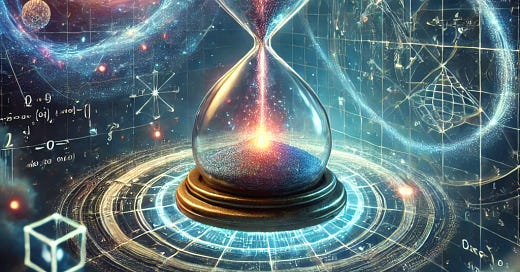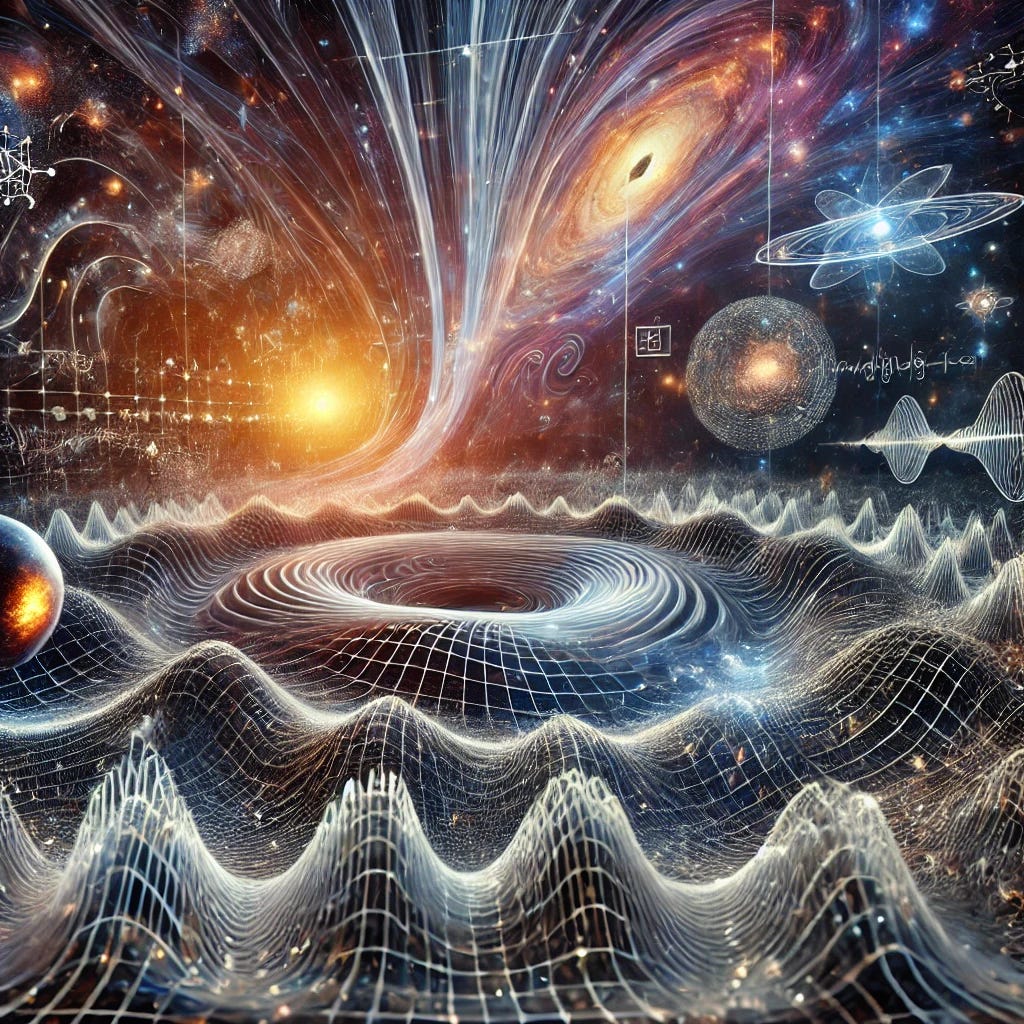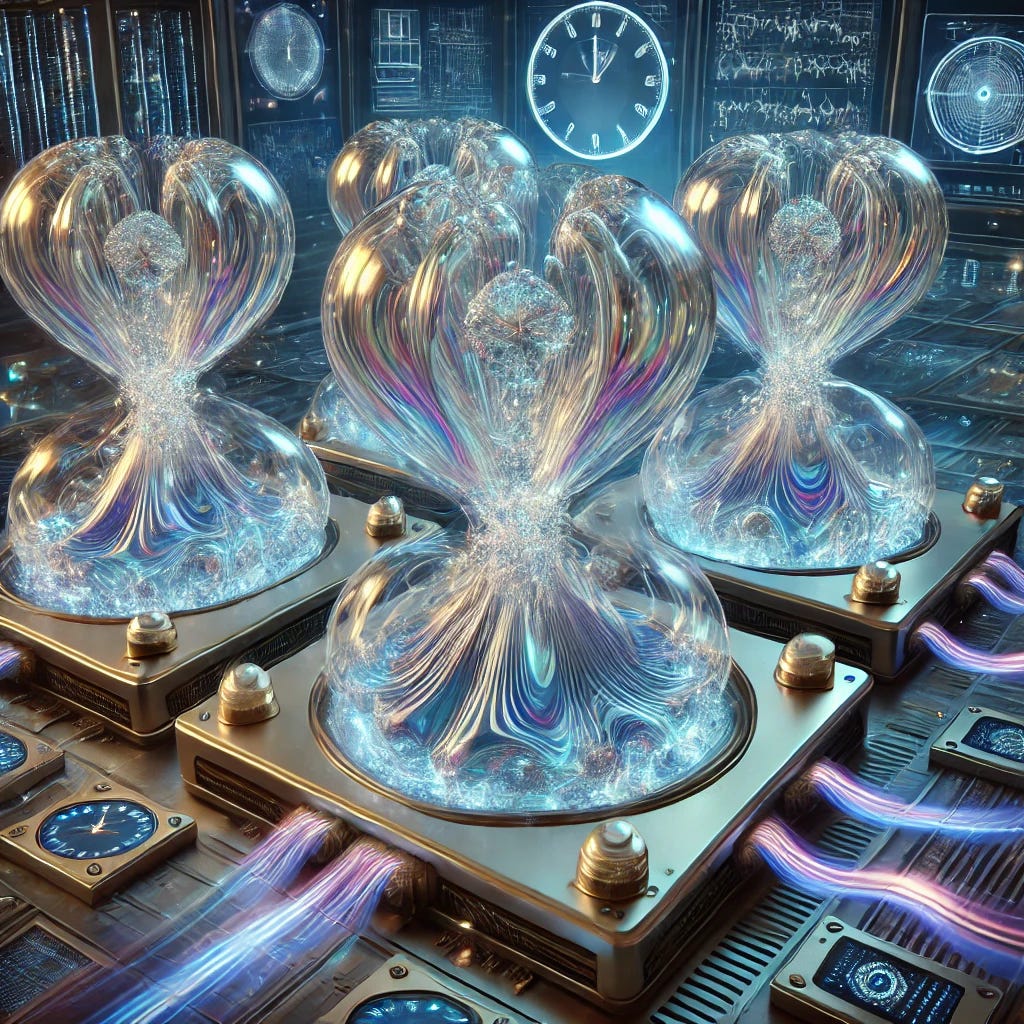Abstract
Traditional physics treats time as a dimension, a coordinate in spacetime akin to length, width, and height. Yet unlike space, time moves inexorably forward, bound to entropy and causality. What if this experience of time, its unidirectionality, persistence, and apparent scarcity, is not merely perceptual or entropic, but indicative of a hidden conserved quantity? This article explores the speculative hypothesis that time might be a conserved physical substance, “chronomatter”, capable of interaction, localization, and exchange. We examine theoretical precedents in physics, propose candidate mechanisms, explore possible empirical signatures, and speculate on technologies that could one day manipulate chronomatter for computation, memory, and causality modulation.
Introduction: Time as a Physical Medium
The passage of time remains one of the deepest mysteries in physics. While general relativity treats time as a coordinate warped by mass and energy, and thermodynamics links time's arrow to entropy, neither framework describes time as a physical substance. We do not speak of accumulating or transferring time in the same way we do with energy or momentum, except metaphorically. But could our metaphors be closer to reality than assumed? Might there exist a physical substrate, chronomatter, that underlies temporal flow, analogous to how the Higgs field underlies mass or the electromagnetic field underlies charge? If so, it would radically transform our understanding of both time and matter.
Theoretical Foundations: Precedents in Physics
Though time is usually treated as a dimension, not a substance, several frameworks hint at deeper structures. The Wheeler-DeWitt equation, in quantum gravity, is famously time-independent, raising the problem of how time emerges at all (Wheeler & DeWitt, 1967). Julian Barbour has proposed that time is an illusion, with the universe consisting of static configurations called "Nows" (Barbour, 1999). Meanwhile, Carlo Rovelli’s loop quantum gravity suggests time emerges from the entanglement and spin networks at the Planck scale (Rovelli, 2004). These ideas erode the classical distinction between time and physicality.
In thermodynamics, time is linked to the growth of entropy, but entropy itself is a function of information, raising the possibility that time is emergent from the state-counting of physical configurations. In quantum mechanics, time is an external parameter, but in decoherence and quantum information theory, temporal order can be ambiguous or reversed under specific entangled conditions (Tegmark, 2000). If time is emergent, then what is it emerging from? Chronomatter proposes that time emerges from the flow or distribution of an unrecognized field or particulate substrate that obeys conservation laws analogous to mass or charge.
Chronomatter: A Working Definition
Chronomatter would be a hypothesized substance or field whose local density or gradient gives rise to the perception of time flow. It may be neither matter nor energy as conventionally defined, but a topological or informational structure embedded in spacetime. It might have properties akin to potential fields, with gradients correlating to relative temporal flow rates. In regions of high chronomatter density, time might slow; in voids, accelerate. Unlike gravitational time dilation, which derives from mass-energy curvature, chronomatter would exist independently, perhaps even governing mass-energy behavior in reverse.
Such a substrate might be non-local or superfluidic in nature. It could manifest through interference effects, similar to the quantum vacuum, or exist as a scalar field permeating all space. Its distribution might align with regions of high information-processing, complexity, or decoherence, suggesting links between time, consciousness, and entropy (Hameroff & Penrose, 2014). This might explain why highly ordered or low-entropy systems (such as black holes or Bose-Einstein condensates) exhibit anomalous time behavior.
Experimental Signatures and Detection Strategies
If chronomatter exists, how would we detect it? We might look for anomalies in time dilation not accounted for by mass or motion, regions where time flows differently despite equivalent gravitational fields. Atom interferometry, optical clocks, and neutrino oscillation studies could be adapted to detect minute phase shifts or time asymmetries. Another approach would be to correlate large-scale anomalies in cosmic time, such as galaxy rotation curves or expansion rates, with non-visible matter distributions that do not match known dark matter profiles.
Alternatively, we could examine low-temperature quantum systems, like superconductors or Bose-Einstein condensates, where decoherence times stretch unusually long. If time is a resource drawn upon by computational or entropic processes, then these systems might hoard or conserve chronomatter, resisting the flow of time like an insulating substrate. If time can be manipulated by concentrating or dispersing this field, then intentional engineering of chronomatter densities might yield testable predictions in quantum coherence duration or temporal sequencing in entangled systems.
Speculative Technologies Based on Chronomatter Manipulation
If chronomatter is real and manipulable, its technological implications would be staggering. The most obvious application would be in temporal modulation: creating zones where time flows faster or slower. This could revolutionize computation, allowing for localized time acceleration within a chip, performing hours of processing in subjective milliseconds. Conversely, storage systems could use chronomatter vacuums to "pause" data aging, preserving states indefinitely without energy expenditure.
In medicine, a high-density chronomatter field might slow cellular processes, suspending biological time and enabling new forms of stasis or cryopreservation. Space travel could benefit from bubble-like chronomatter insulators that dampen subjective time for interstellar voyages. Psychologically, modulation of chronomatter near the brain might alter the perception of time, potentially useful for trauma treatment or enhanced learning.
More speculative still, if consciousness interacts with chronomatter, perhaps as a carrier or interpreter of time, then directed chronomatter flows could influence subjective awareness. This raises ethical concerns, but also the tantalizing possibility of tuning our experience of time for cognitive enhancement or philosophical insight.
Chronomatter-based engineering might also allow for temporal shielding in quantum computing, isolating qubits from decoherence by surrounding them with time-insulating membranes. Such technologies would not simply accelerate progress; they would redefine the temporal substrate upon which progress operates.
Rethinking the Fundamentals of Time
Chronomatter remains a highly speculative notion, but one grounded in dissatisfaction with existing theories of time. It offers a way to reconcile entropy, quantum information, and relativity by proposing a hidden substrate whose presence structures temporal experience. If proven real, chronomatter would rank alongside mass and energy as a fundamental component of physical law. It could answer ancient questions about why time flows, why it flows in one direction, and how it might one day be sculpted. The first step is conceptual, imagining time not as an illusion or a parameter, but as a material waiting to be mapped.
References
Barbour, J. (1999). The End of Time: The Next Revolution in Physics. Oxford University Press.
Hameroff, S., & Penrose, R. (2014). Consciousness in the universe: A review of the 'Orch OR' theory. Physics of Life Reviews, 11(1), 39–78. https://doi.org/10.1016/j.plrev.2013.08.002
Rovelli, C. (2004). Quantum Gravity. Cambridge University Press.
Tegmark, M. (2000). Importance of quantum decoherence in brain processes. Physical Review E, 61(4), 4194–4206. https://doi.org/10.1103/PhysRevE.61.4194
Wheeler, J. A., & DeWitt, B. S. (1967). Quantum theory of gravity. I. The canonical theory. Physical Review, 160(5), 1113–1148. https://doi.org/10.1103/PhysRev.160.1113







Your exploration of chronomatter is both imaginative and intellectually provocative—stretching the boundary between speculative physics and philosophical inquiry. The idea of time as a tangible substance, rather than a mere dimension or emergent property, invites a reexamination of causality, entropy, and even the biological constraints of life itself. If chronomatter exists and could be manipulated, the implications for aging, perception, and even temporal agency are staggering. While the concept currently lives in the realm of thought experiment, it echoes the spirit of early quantum speculation—audacious, unsettling, and potentially transformative. I appreciate how your piece balances wonder with rigor, opening doors rather than closing them.
That said, I’m genuinely curious—what drives you to write these pieces? Are you a scientist, a student, or something else entirely? I find your work consistently fascinating, but I’ve realized I’m now just as interested in why you write it as I am in what you write.